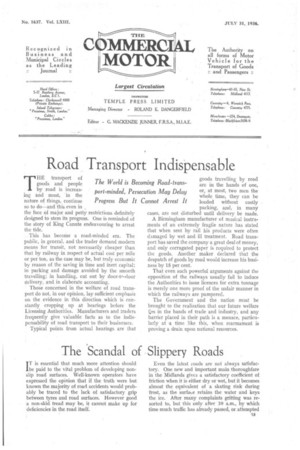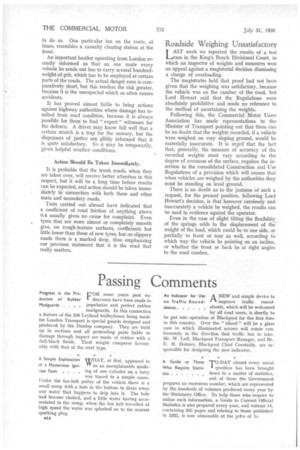The 'Scandal of Slippery Roads
Page 19

Page 20

If you've noticed an error in this article please click here to report it so we can fix it.
IT is essential that much more attention should be paid to the vital problem of developing nonslip road surfaces. Well-known operators have expressed the opinion that if the truth were but known the majority of road accidents would probably be traced to the lack of satisfactory grip between tyres and road surfaces. However good a non-skid tread may be, it cannot make up for deficiencies in the road itself. Even the latest roads are not always satisfactory. One new and important main thoroughfare in the Midlands gives a satisfactory coefficient of friction when it is either dry or wet, but it becomes almost the equivalent of a skating rink during frost, as the surf ate retains the water, and keys the ice. After many complaints gritting was resorted to, but this only after 10 a.rn, by which time much traffic has already passed, or attempted to do so. One particular inn on the route, at times, resembles a casualty clearing station at the front.
An important haulier operating from London recently informed us that on one route every vehicle he sends out has to carry several hundredweight of grit, which has to be employed at certain parts of the roads. The actual danger zone is comparatively short, but this renders the risk greater, because it is the unexpected which so often causes accidents.
It has proved almost futile to bring actions against highway authorities where damage has resulted from road condition, because it is always possible for them to find " expert " witnesses for the defence. A driver may know full well that a certain stretch is a trap for the unwary, but the dispensers of ,justice are glibly informed that it is quite satisfactory. So It may be temporarily, given helpful weatherconditions.
Action Should Be Taken Inunediately.
It is probable that the trunk roads, when they are taken over, will receive better attention in this respect, but it will be a long time before results can be expected, and action should be taken immediately in connection with both these and other main and secondary roads.
Tests carried out abroad have indicated that a coefficient of road friction of anything above 0.4 usually gives no cause for complaint. Even tyres that are worn almost or completely smooth give, on rough-texture surfaces, coefficients but little lower than those of new tyres, but on slippery roads there is a marked drop, thus emphasizing our previous statement that it is the road that really matters.
Roadside Weighing Unsatisfactory
L I AST week we reported the results of a test ease in the King's Bench Divisional Court, in which an inspector of weights and measures won an appeal against a magisterial decision dismissing a charge of overloading. The magistrates held that proof had not been given that the weighing was satisfactory, because the vehicle was on the camber of the road, but Lord Hewart said that the Regulations were absolutely prohibitive and made no reference to the method of ascertaining the weights. Following this, the Commercial Motor Users Association has made representations to the Minister of Transport pointing out that there can be no doubt that the weights recorded, if a vehicle were weighed on very sloping ground, would be materially inaccurate. It is urged that the fact that, generally, the measure of accuracy of the recorded weights must vary according to the degree of evenness of the surface, requires the insertion in the consolidated Construction and Use Regulations of a provision which will ensure that when vehicles are weighed by the authorities they must be standing on level ground.
There is no doubt as to the justness of such a request, for the present position, following Lord Hewart's decision, is that however carelessly and inaccurately a vehicle be weighed, the results can be used in evidence against the operator.
Even in the case of slight tilting the flexibility of the springs adds to the displacement of the weight of the load, which could be to one side, or partially to front or rear as well, according to which way the vehicle be pointing on an incline, or whether the front or back be at right angles to the road camber.












































































